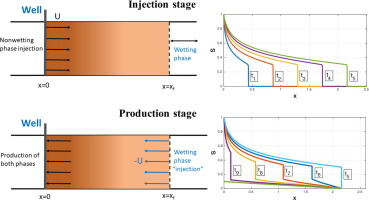当前位置:
X-MOL 学术
›
J. Hydrol.
›
论文详情
Our official English website, www.x-mol.net, welcomes your
feedback! (Note: you will need to create a separate account there.)
An analytical solution for cyclic flow of two immiscible phases
Journal of Hydrology ( IF 5.9 ) Pub Date : 2019-03-01 , DOI: 10.1016/j.jhydrol.2018.12.056 Avinoam Rabinovich
Journal of Hydrology ( IF 5.9 ) Pub Date : 2019-03-01 , DOI: 10.1016/j.jhydrol.2018.12.056 Avinoam Rabinovich

|
Abstract Cyclic injection and production by a single well is a technique used in applications such as natural gas storage, compressed air energy storage and periodic pumping tests. The induced flow and saturation distribution can sometimes be modeled assuming two immiscible and incompressible fluids. An analytical solution is derived for such one-dimensional cyclic flow using the method of characteristics. The solution usually exhibits a front or discontinuity, in which case the contour integral method is applied in the derivation. Saturation (S) is expressed as a function of time, distance from well, mobility ratio and production to injection time ratio t prod / t inj . Derivation is carried out for both linear S ( x ) and radial S ( r ) flow. Dependence of the solution on these parameters is explored and various cases are analyzed. A simple model for viscosity reduction of the reservoir fluid is presented, accounting for changes in mobility ratio, e.g., following cyclic injection for enhanced oil recovery. It is found that generally, for t prod / t inj ⩾ 1 the solution converges to a periodic steady state, however, for t prod / t inj 1 or when accounting for viscosity reduction, such a state is not reached and the injected phase penetrates deeper with each cycle.
中文翻译:

两不混相循环流动的解析解
摘要 单井循环注采是一种应用于天然气储存、压缩空气储能和周期性抽油试验的技术。有时可以假设两种不混溶和不可压缩的流体来模拟诱导流动和饱和度分布。使用特征法推导出此类一维循环流的解析解。解通常表现出前沿或不连续性,在这种情况下,在推导中应用等高线积分法。饱和度 (S) 表示为时间、与井的距离、流度比和生产与注入时间比 t prod / t inj 的函数。对线性 S ( x ) 和径向 S ( r ) 流进行推导。探索了解决方案对这些参数的依赖性,并分析了各种情况。提出了一种用于降低油藏流体粘度的简单模型,其中考虑了流度比的变化,例如,为提高采油率而进行的循环注入之后。发现通常,对于 t prod / t inj ⩾ 1,解收敛到周期性稳态,但是,对于 t prod / t inj 1 或考虑粘度降低时,未达到这种状态并且注入相渗透每个周期更深。
更新日期:2019-03-01
中文翻译:

两不混相循环流动的解析解
摘要 单井循环注采是一种应用于天然气储存、压缩空气储能和周期性抽油试验的技术。有时可以假设两种不混溶和不可压缩的流体来模拟诱导流动和饱和度分布。使用特征法推导出此类一维循环流的解析解。解通常表现出前沿或不连续性,在这种情况下,在推导中应用等高线积分法。饱和度 (S) 表示为时间、与井的距离、流度比和生产与注入时间比 t prod / t inj 的函数。对线性 S ( x ) 和径向 S ( r ) 流进行推导。探索了解决方案对这些参数的依赖性,并分析了各种情况。提出了一种用于降低油藏流体粘度的简单模型,其中考虑了流度比的变化,例如,为提高采油率而进行的循环注入之后。发现通常,对于 t prod / t inj ⩾ 1,解收敛到周期性稳态,但是,对于 t prod / t inj 1 或考虑粘度降低时,未达到这种状态并且注入相渗透每个周期更深。











































 京公网安备 11010802027423号
京公网安备 11010802027423号